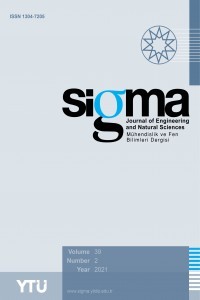Optimization of colour pigments removal from palm oil using activated ogbunike kaolinite
Optimization of colour pigments removal from palm oil using activated ogbunike kaolinite
Optimization, ANOVA, bleaching, genetic algorithm, kaolinite.,
___
- [1] Nwankwere E. T., Nwadiogbu J. O., Yileng M. T., Eze K. A., (2012) Kinetic Investigation of the Adsorptive Removal of B-carotene Pigments from Oil Using Unmodified Natural Clay, Advances of Applied Science Research, 3(2), 1122-1125.
- [2] Khan T. A., Dahiya S., Ali I., (2012) Use of Kaolinite as Adsorbent: Equilibrium, Dynamics and Thermodynamic Studies on the Adsorption of Rhodamine B from Aqueous Solution, Applied Clay Science, 69, 58-66.
- [3] Annadurai G., Juang R. S., Lee D. J., (2002) Factorial Design Analysis of Adsorption of Activated Carbon on Activated Carbon Incorporated with Calcium Aginate, Advances in Environmental Research, 6, 191 -198.
- [4] Chew S. C., Tan C. P., Nyam K. I., (2017) Optimization of Neutralization Parameters in Chemical Refining of Kenaf Seed Oil by Response Surface Methodology, Industrial Crops and Products, 95, 742-750.
- [5] Kumar A., Prasad B., Mishra I. M., (2008) Adsorptive Removal of Acrylonitrile Using Powdered Activated Carbon, Journal of Environmental Protection Science, 2, 54-62.
- [6] Fayyazi E., Ghobadian B., Najafi G., Hosseinzadeh B., Mamat R., Hosseinzadeh J., (2015) An Ultrasound-Assisted System for the Optimization of Biodiesel Production from Chicken Fat Oil Using a Genetic Algorithm and Response Surface Methodology, Ultrasonics Sonochemistry, 26, 312-320.
- [7] Singh V., Khan M., Khan S., Tripathi C., (2009) Optimization of Actinomycin V Production by Streptomyces Triostinicus Using Artificial Neural Network and Genetic Algorithm, Applied Microbiology and Biotechnology, 82, 379-385.
- [8] Gupta J. N., Sexton R. S., (1999) Comparing Back Propagation With a Genetic Algorithm for Neural Network Training, Omega, 27, 679-684.
- [9] Shen C., Wang L., Li Q., (2007) Optimization of Injection Molding Process Parameters Using Combination of Artificial Neural Network and Genetic Algorithm Method, Journal of Materials Processing Technology, 183, 412-418.
- [10] Ajemba R. O., (2012) Optimum Activation Conditions of Ughelli Bentonite for Palm Oil Bleaching Using Response Surface Methodology, Australian Journal of Basic and Applied Sciences, 6(12), 186 – 197.
- [11] Ighose B. O., Adeleke I. A., Damos M., Junaid H. A., Okpalaeke K. E., Betiku E., (2017) Optimization of Biodiesel Production from Thevetia Peruviana Seed Oil by Adaptive Neuro-Fuzzy Inference System Coupled with Genetic Algorithm and Response Surface Methodology, Energy conversion and Management, 132, 231- 240.
- [12] Nnanwube I. A., Onukwuli O. D., Ajana, S. U., (2018) Modeling and Optimization of Galena Dissolution in Hydrochloric Acid: Comparison of Central Composite Design and Artificial Neural Network, Journal of Minerals and Materials Characterization and Engineering, 6, 294 – 315.
- ISSN: 1304-7191
- Başlangıç: 1983
- Yayıncı: Yıldız Teknik Üniversitesi
Merve ŞEN KURT, Ahmet FENERCİOĞLU
Investigation the modeling of genetic algorithm based vehicle powertrain system optimization
Mehmet Onur GENÇ, Alper KARADUMAN
Optimization of colour pigments removal from palm oil using activated ogbunike kaolinite
Ikechukwu Abuchi NNANWUBE, Vincent Nwoye OKAFOR, John Ifeanyi OBIBUENYI, Okechukwu Dominic ONUKWULI, Regina Obiageli AJEMBA
Satish Kumar DEWANGAN, Santosh Kumar SENAPATI, Vivek DESHMUKH
Shahin AHMADI, Chinenye Adaobi IGWEGBE
A comparative study on the thermal performance of mortars with different formulations
Nihat KABAY, Ahmet B. KIZILKANAT
Ali MARDANI AGHABAGLOU, Süleyman ÖZEN, Muhammet Gökhan ALTUN, Zia Ahmad FAQIRI
An investigation into the performance of hss drills when drilling commercially pure molybdenum
